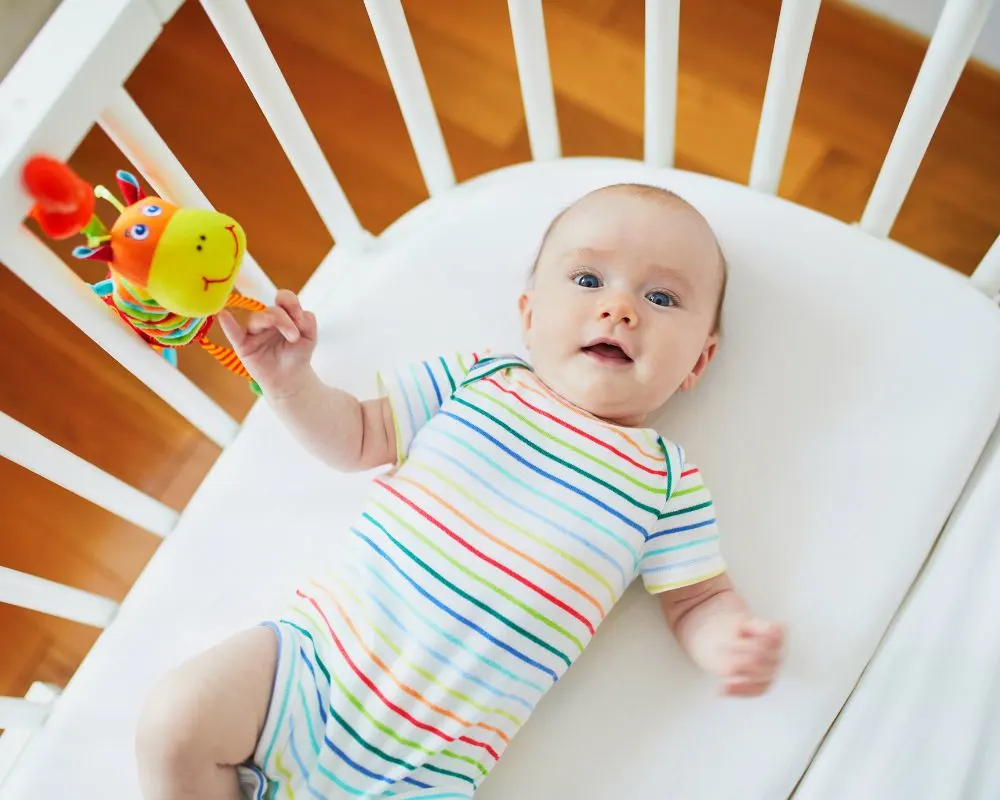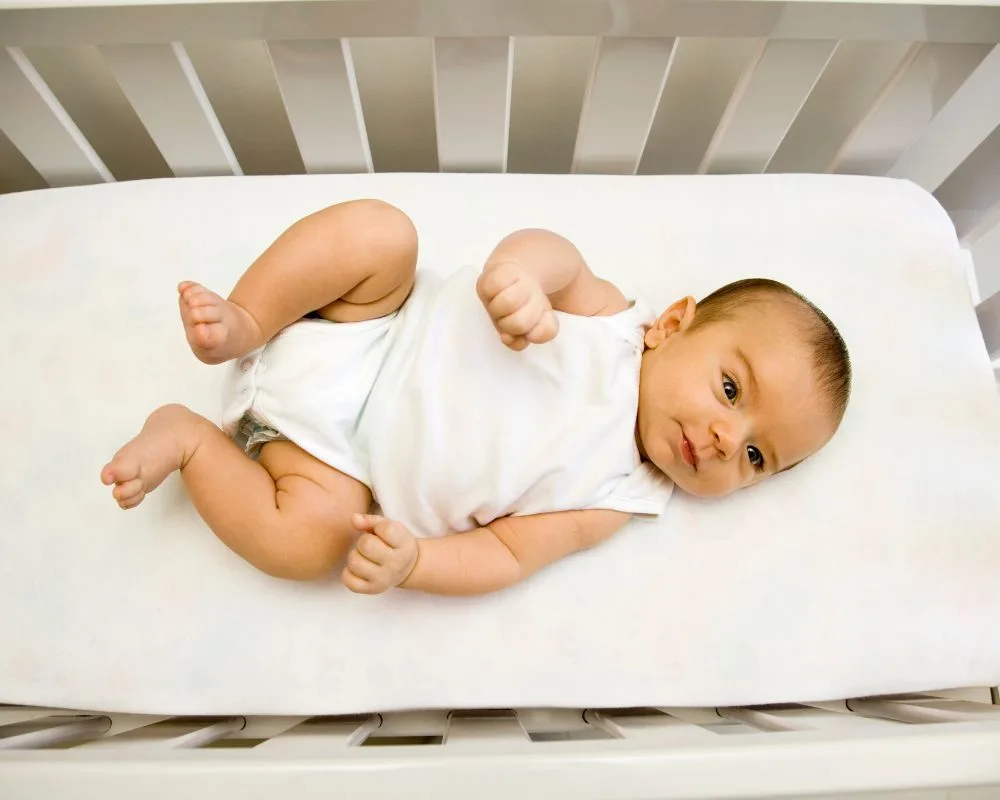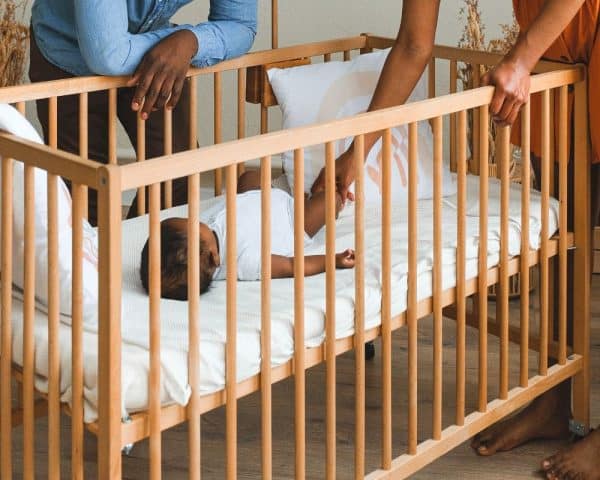Have you ever wondered about the one hour crib rule? It’s a concept that might intrigue and even challenge some parents out there. You see, the one hour crib rule is all about finding that delicate balance between allowing your baby to cry and soothing them to sleep, all within the timeframe of one hour. It’s an approach that aims to teach your little one how to self-soothe and fall asleep independently. In this article, we will explore the ins and outs of this intriguing rule and discuss its potential benefits and considerations. So, if you’re curious about how to navigate those sleepless nights with a little one, keep reading to discover the fascinating world of the one hour crib rule.
This image is property of i0.wp.com.
Review contents
What is the one hour crib rule?
Definition of the one hour crib rule
The one hour crib rule is a sleep training method that involves placing a baby in their crib within one hour of their bedtime routine. It is a gentle approach to encourage independent sleep and help babies develop healthy sleep habits. The rule suggests that parents should aim to have their baby fall asleep on their own within one hour of being placed in the crib.
Purpose of the one hour crib rule
The main purpose of the one hour crib rule is to promote independent sleep and establish consistent routines for babies. By encouraging babies to fall asleep on their own, this method helps them develop self-soothing skills and reduces their reliance on external comfort, such as being held or rocked to sleep. The one hour crib rule also aims to improve the quality of a baby’s sleep and create a conducive sleep environment.
Implementation of the one hour crib rule
Implementing the one hour crib rule involves following a few key steps. Firstly, parents need to establish a bedtime routine for their baby that includes calming activities such as bathing, reading a book, or singing a lullaby. Within one hour of starting this routine, the baby should be placed in their crib while still awake. Parents should then give their baby some time to settle themselves to sleep, resisting the temptation to intervene immediately if the baby becomes upset. The goal is to gradually teach the baby to fall asleep independently within the one hour timeframe.
Factors to consider before implementing the one hour crib rule
Age of the baby
Before implementing the one hour crib rule, it is essential to consider the age of the baby. While this method can be effective for infants as young as a few months old, it may not be suitable for newborns or very young babies who still require frequent nighttime feedings. Consulting with a pediatrician to determine if the baby is developmentally ready for this approach is advisable.
Physical and mental development
The physical and mental development of the baby should also be taken into account. Babies develop at different rates, and their ability to self-soothe and fall asleep independently varies. If the baby is not reaching developmental milestones related to sleep, such as rolling over or sitting up, it may be best to wait before implementing the one hour crib rule.
Sleep patterns
Understanding the baby’s sleep patterns is crucial when considering the one hour crib rule. Some babies naturally have longer sleep stretches, while others may be prone to frequent awakenings. If a baby consistently wakes up every hour or has other sleep issues, it may be necessary to address those concerns before attempting this sleep training method.
Safety precautions
Ensuring the safety of the baby is of utmost importance. Before implementing the one hour crib rule, parents need to assess the crib environment for potential hazards. The crib should be clear of blankets, pillows, and stuffed animals to reduce the risk of suffocation. Additionally, it is essential to ensure the crib meets safety standards and is free from loose parts or structural issues.
Benefits of the one hour crib rule
Promotes independent sleep
One of the significant benefits of the one hour crib rule is that it promotes independent sleep in babies. By encouraging them to fall asleep on their own, babies learn to self-soothe and become more capable of putting themselves back to sleep if they wake up during the night. This promotes healthy sleep habits and can lead to more peaceful nights for both the baby and the parents.
Ensures consistent routines
Implementing the one hour crib rule helps establish consistent bedtime routines for babies. By having a set routine every night, babies become familiar with the process and find comfort in the predictability of their bedtime. Consistency in routines can create a sense of security for babies, making it easier for them to transition from being awake to falling asleep.
Improves sleep quality
Another benefit of the one hour crib rule is that it can lead to better sleep quality for babies. When babies learn to fall asleep independently, they are less likely to wake up fully during the night, resulting in more consolidated and restful sleep. Improved sleep quality not only benefits the baby’s well-being but also enhances the overall functioning of the family unit.
Encourages self-soothing
The one hour crib rule encourages babies to develop self-soothing skills. By allowing them the opportunity to settle themselves to sleep, babies learn to rely on internal cues and techniques to calm themselves down. This fosters their emotional and cognitive development, as they become more capable of managing their own emotions and regulating their stress levels.
Challenges of implementing the one hour crib rule
Resistance from the baby
Implementing the one hour crib rule can come with challenges, including resistance from the baby. Some babies may initially resist falling asleep on their own or become upset when placed in the crib. It is crucial for parents to remain patient and consistent, as babies may require time to adjust to this new sleep routine.
Adjustment period
Babies may require an adjustment period when implementing the one hour crib rule. This can mean that the first few nights or weeks may be challenging, as the baby learns to self-soothe and establish a new sleep routine. It is important for parents to be prepared for this adjustment period and to provide support and reassurance to their baby during this time.
Potential disruptions to routines
Implementing the one hour crib rule may lead to potential disruptions in daily routines, as parents may need to invest more time and effort into helping their baby adjust to this new sleep approach. This may require adjustments to evening schedules and routines, such as allowing extra time for the bedtime routine or potentially rearranging other family activities.
Parental anxiety and concerns
Parents may experience anxiety and concerns when implementing the one hour crib rule. It is natural for parents to worry about their baby’s well-being, especially when making changes to their sleep routines. Seeking support from healthcare professionals or joining parenting communities can help alleviate any anxieties and provide guidance throughout the process.
This image is property of thepostpartumparty.com.
Tips for successfully implementing the one hour crib rule
Gradual transition
A gradual transition is key to successfully implementing the one hour crib rule. Instead of abruptly introducing the new sleep routine, parents can begin by gradually increasing the amount of time the baby spends in the crib awake. For example, starting with 10 minutes and gradually extending it to an hour over several nights or weeks.
Establishing a bedtime routine
Creating a consistent bedtime routine is important when implementing the one hour crib rule. A soothing routine, such as a warm bath followed by a quiet activity like reading or singing, can help signal to the baby that it is time to wind down and prepare for sleep. Consistency and predictability in the routine can help the baby associate these activities with sleep and facilitate the transition to the crib.
Creating a conducive sleep environment
Creating a conducive sleep environment is essential for successful implementation of the one hour crib rule. The baby’s room should be quiet, dark, and at a comfortable temperature. Using white noise machines or other soothing sounds can also contribute to a calming sleep environment. Additionally, ensuring the crib and mattress are of high quality, supportive, and comfortable can further enhance the baby’s sleep experience.
Using comforting objects
Introducing a comforting object, such as a soft blanket or a beloved stuffed animal, can provide additional reassurance to the baby when implementing the one hour crib rule. These objects can serve as transitional items, helping the baby feel secure and connected when falling asleep independently. It is essential to choose safe objects that do not pose any hazards and are age-appropriate.
Consistency and persistence
Consistency and persistence are key elements to successfully implementing the one hour crib rule. Babies thrive on routine and predictability, so it is crucial for parents to remain consistent with their approach. This includes consistently following the bedtime routine, using the same cues and soothing techniques, and being persistent in allowing the baby to self-soothe and fall asleep independently.
Expert recommendations regarding the one hour crib rule
Importance of individualized approaches
Experts emphasize the importance of individualized approaches when implementing the one hour crib rule. Every baby is unique and may have different needs and capabilities when it comes to self-soothing and sleep. It is essential for parents to tailor the approach to their baby’s temperament, developmental stage, and overall well-being. Flexibility and adaptability are key to finding what works best for each individual baby and family.
Consulting with pediatricians
Consulting with pediatricians is highly recommended before implementing the one hour crib rule. Pediatricians can provide valuable guidance and support, as well as assess any underlying medical or developmental factors that may affect the baby’s sleep. They can also address any concerns or questions parents may have, ensuring the approach is safe and appropriate for their baby’s individual circumstances.
Alternative methods and strategies
While the one hour crib rule can be effective for many families, experts also recognize that it may not be the right fit for everyone. There are alternative sleep training methods and strategies available to suit different parenting styles and baby temperaments. From gentle approaches, such as the pick-up-put-down method, to more structured methods, like controlled comforting or controlled crying, parents can explore various options to find the best fit for their family.
This image is property of thepostpartumparty.com.
Common misconceptions about the one hour crib rule
Forcing babies to sleep alone
One common misconception about the one hour crib rule is that it forces babies to sleep alone. However, this approach is not about abandoning or neglecting the baby. Instead, it aims to help them develop independent sleep skills that can benefit their overall well-being and sleep quality. Parents should practice responsive care during the adjustment period and be available to offer comfort when needed.
Neglecting their needs
Another misconception is that the one hour crib rule neglects the baby’s needs for comfort and reassurance. On the contrary, this method encourages parents to provide a safe and supportive sleep environment for their baby. By gradually teaching the baby to fall asleep independently, parents are helping them build self-soothing skills and promoting healthy sleep habits.
Causing long-term sleep issues
Some may worry that the one hour crib rule could lead to long-term sleep issues for the baby. However, when implemented correctly and with consideration of the baby’s individual circumstances, this approach does not cause long-term sleep problems. In fact, the one hour crib rule aims to establish healthy sleep habits that can benefit the baby’s sleep patterns and overall well-being in the long run.
Success stories and experiences with the one hour crib rule
Parent testimonials
Many parents have shared their success stories and positive experiences with the one hour crib rule. They have observed improvements in their baby’s ability to fall asleep independently, longer stretches of sleep during the night, and overall improved sleep quality for the entire family. Parents often report feeling more rested and having a greater sense of predictability and control over their baby’s sleep routine.
Benefits observed
Parents who have implemented the one hour crib rule have noticed various benefits. Babies often become more confident and independent sleepers, which can lead to improved mood and behavior during waking hours. Additionally, parents often find that their evenings become more relaxed and enjoyable, as they can have some dedicated time for themselves or to spend with other family members.
This image is property of thepostpartumparty.com.
Criticism and controversy surrounding the one hour crib rule
Opposing viewpoints
As with any sleep training method, there are opposing viewpoints and criticisms surrounding the one hour crib rule. Some argue that it may be too rigid or go against the natural instinct of parents to attend to their baby’s needs immediately. Others believe that babies should not be expected to self-soothe at such a young age and that sleep training approaches should be delayed until they are older.
Alternative sleep training methods
Due to the controversy surrounding the one hour crib rule, alternative sleep training methods have emerged. These methods focus on more gradual approaches, such as fading, where parents gradually reduce their involvement in the baby’s sleep routine over time. Other methods, like the “no cry” method, prioritize minimizing distress for both the baby and the parent during the sleep training process.
Conclusion
In conclusion, the one hour crib rule is a sleep training method aimed at promoting independent sleep and establishing consistent routines for babies. While it can be effective in helping babies develop self-soothing skills and improving sleep quality, it is essential to consider individual factors such as the baby’s age, development, sleep patterns, and safety precautions. Implementing the one hour crib rule requires patience, consistency, and persistence, and it can lead to numerous benefits for both the baby and the entire family. As with any sleep training method, it is important for parents to consult with pediatricians, consider alternative approaches, and be responsive to their baby’s needs throughout the process.
This image is property of thepostpartumparty.com.



































